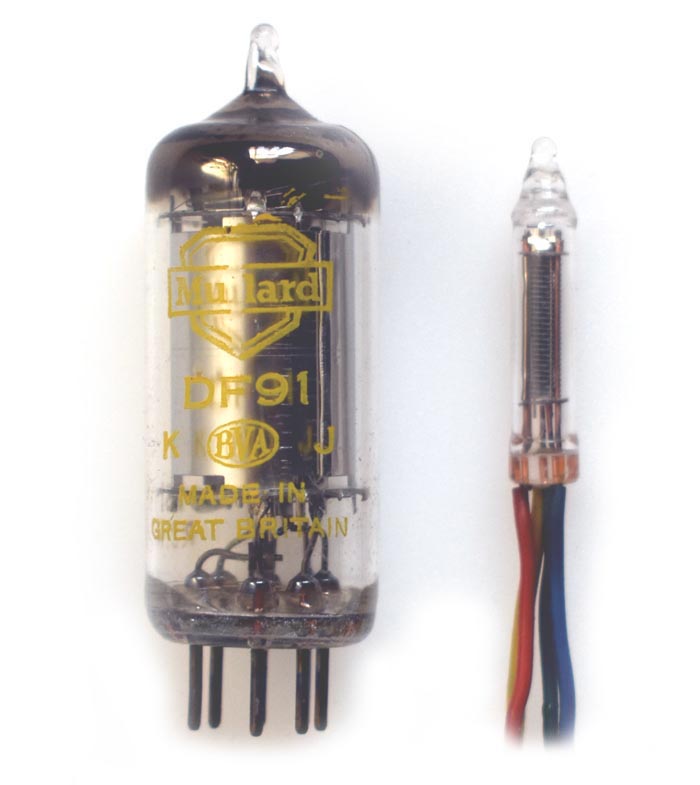








Thermionic valves
Vacuum Tubes or Valves: Are basically obsolete, replace by semiconductors, but a few special instances are still present. X-ray tubes and magnetrons still work by thermionic emission making them electrically both diode valves. While not easy to miniaturise and mechanically fragile, electrically they are quite robust and can handle fault conditions better than transistors. The are also works of art to look at.
Battery powered Miniature valves The very small vacuum tube shown above is just over 1" (2.5cm) long. Its tube construction is similar to a small neon indicator lamp and was taken from an old 1960's tape recorder. It appears to have two grids making it a Tetrode. A thin directly heated wire cathode is used, as was common on battery operated valves. The anode is a plate on one side so the grids are visible inside. 'Mouse over' to see close-up with heater on. The valve on the left is also designed for portable battery equipment before transistors.
The Thyratron: Now replaced with the thyristor or SCR (silicon controlled rectifier). These are gas or vapour filled triggered rectifiers has been superseded by the solid state device, known as a thyristor or SCR . The Thyratron was used in applications of high current DC control, such as motor controllers. Shown here are mercury, Hydrogen, and Xenon thyratrons
Vidicon Tube: These tubes were used in video cameras to convert images into electrical signals. They have been replaced since the early 1990's with the advent of the Charged Coupled Device (CCD)on silicon. The tubes employ an electron gun and electromagnetic deflection as in a television CRTs. Instead of the electron beam being scanned over a phosphor coated screen, the vidicon electron beam scans a light sensitive coating. The coating's electrical resistance varies with light intensity. The beam current is therefore modulated by the light on the coating. The optical shutter seen on one of the tubes below allows a colour signal to be formed using red, blue and green filtering. The deflection and focusing coils which normally completely surround the tubes have been removed.
Vacuum Fluorescent: These were commonly found in consumer electronic products. In this example the 7-segment figure 8 is clear. However, many displays have complete words, icons and symbols. They operate like a valve, in that there is a heated cathode, control grid and anodes. The anode is coated with a fluorescing material. Many colours can be used in one display. A number of fine wires run across the front of the display. These are heated by a small current and form the cathodes. The electrons emitted can travel to the anode if permitted to pass by the charge on the mesh grids in front of the fluorescing anodes. Although these displays were popular in the 80's and 90's they are becoming less so now due to their power consumption and higher voltage drive circuits. The complete display is evacuated. The dark patch on the bottom right is 'getter' to preserve the high vacuum during the display's lifetime.
Magnetron: Primary Radar Magnetron without magnet. Manufactured by English Electric valve Co. Type 4J44 2974Mhz. The heater and cathode connections are out of sight at the top of the white plastic case.
X-ray tube: This small X-ray tube has a heated cathode shown running. X-rays emitted from the fixed target anode emerge through the Beryllium window on the side of the tube. Image link for more info:
Magic Eye: This is an early indicator valve known as a 'Magic Eye' used to indicate signal strength. A grid voltage controls the beam pattern landing on the anode. The anode surface is coated with fluorescent paint which glows green when hit by electrons.
Kenotron: This large diode valve(45cm long)is generally known as a Kenotron. These were often used in x-ray power supplies but this particular one was for use in military radar during WWII. The part number is CV19 and it is capable of handling peak reverse voltages of 68kV. Shown here with the filament running on a 9V supply the actual heater voltage is quoted at 17V making it very bright. Although now replaced by silicon diodes, these valves can still prove to be more robust under stress conditions.
TWT: Travelling wave tube (TWT) used in micro-wave and radar transmitters. This one is shown with the electron gun and tube dismantled from its enclosure. The casing contains the input and output wave guides and the magnets that surround the tube.
